I have wanted to dye Easter Eggs with food for years and finally tried it. This was such a fun project with surprising and, sometimes, puzzling results. Most of the ideas were after surfing the internet, googling ‘easter egg dyeing with food.’ There are so many people out there doing this and so many different final products. I decided I was going to try it out and give you one more opinion on whether it’s worth the effort.
Before I started, I felt I needed some traditional guidelines on how to dye Easter Eggs and went to the do-all, end-all of any project: Martha Stewart. She has an excellent ‘Egg Dyeing 101′ article on her website that is truly informative, with pictures and detailed instructions. Here’s the web address with all the hints: http://www.marthastewart.com/275626/egg-dyeing-101/@center/276968/easter#/217385.
One hint I tried and loved was the Egg Drying Rack. You make this with a piece of foam core (mine was 12×12″) and draw a 1″ grid on it. Then in the corner of each square, you place a sewing pin. After an egg has been dyed, you place the egg on the pins and it holds it up so there are no marks left on the surface. I loved this idea. For years and years I tried all kinds of ways to keep the eggs from being marked up and the only thing I could do to prevent any of that happening was to hold it gently with the nails of my thumb and forefinger and walk around with it until it dried. As you can imagine, dyeing a dozen or more eggs took quite a while!
the best egg drying method ever! It doesn’t take long to draw the lines, but it does take a little patience to put in the pins. Well worth it!
Now, let’s get going on the food dyeing part. I will do this by color, stating what I used, how it was processed and whether or not I thought the end result was worth doing it again.
If you are going to make this a Kid Project, be sure the little ones are wearing clothes you don’t mind getting a little more colorful. And protect the work area with newspaper or butcher paper to keep any of the dyes ruining the surface. I didn’t experience any trouble with that, but you never know.
Eggs-To Cook or Not to Cook
There are two theories about this. The Hot Method is cooking the eggs with the ingredients. This can cause the dye to scrape off easily (usually with the fruit dyes) or the hot method helps the dye adhere to the egg better. I did it both ways. What I found with the eggs that were cooked with the ingredients was the egg became ‘mottled’; which isn’t bad, in my opinion. I think it added character. I put already boiled eggs in a jar with the solids as well as the liquid and the eggs got an interesting pattern and I believe that was due to their being up against the solid parts during the dyeing process.
The Cold Method is where you strain the dye and put the boiled egg in and let it sit for 2 hours or even overnight. The shorter time created a more muted color whereas the overnight colors were much brighter or richer.
Vinegar and/or Baking Soda
We are all aware that vinegar is necessary to help the dye stick to the egg and there are some who say add baking soda to create a better result. Baking soda was also recommended when using leafy green vegetables to help release the color from the leaves. I used vinegar in my processes and was satisfied enough to not worry about using the baking soda for the non-leafy vegetables.
Wide Mouth Jars
Over the years, I have tried using all kinds of containers to dye Easter Eggs with and found that Wide Mouth Pint Jars work the best. The top is wide enough to place the egg in gently and for using a large spoon to scoop the egg out. It’s recommended that you refrigerate the dye so I place the jars on a baking sheet or the box you buy them in and put them in the refrigerator.
Different Colors
These recipes are ones that I tried but there are many more on the internet. Try even experimenting with some of your spices in your spice cabinet.
Red Eggs
I read that beets red onion skins, cherries, and cranberries are good to use to get red or pink. I tried canned beets and cherries and the only color I could get was grey and black. That says Easter, doesn’t it? I’m not sure what I did to get those colors but will keep it in mind next Halloween! I think it had something to do with them being canned products. I tried fresh beets and the red onion skins and had terrific results. The beets created a real, pretty pink or salmon and the onion skins created a beautiful ruby or garnet color. I added cranberry juice to the beets and it created a darker pink, almost fuchsia.
Peels of Red Onions
6 cups water
1T Vinegar
Boil for 30 minutes. Let cool and and strain through coffee filter or cheesecloth-lined colander.
red onion skin: left in solution overnight created a deep burgundy
Red Beets
3-4 red beets, coarsely chopped
enough water to cover beets
Bring to boil; simmer for 30 minutes. Let cool and strain.
Dark Cherries
1 pk frozen dark cherries
water to cover fruit
2 T Vinegar
Bring to boil; simmer 15 minutes. Strain and let cool. Strain through a cheesecloth-lined strainer to get any foamy material out of liquid.
dark red cherries: left in solution created a garnet-colored egg
I really love the color of this dye on the eggs. Like the red onion skins, it creates a real rich, deep burgundy.
YELLOW
Turmeric and Green Tea work well to get this color. I prefer the turmeric overnight; it created a rich yellow. The green tea created a lighter, more pastel yellow.
Turmeric
5 C water
1/4 cup turmeric
2 T Vinegar
Boil for 5 minutes; simmer for 30 more. Filter the turmeric dye mixture through a coffee filter inside a strainer to get rid of the excess turmeric. Let cool.
turmeric: such a rich color-probably my favorite
Green Tea
7 tea bags
3 C water
1 T Vinegar
Boil for 5 minutes; simmer for 25 more. A fairly short soak makes a nice, pale yellow and overnight created a darker version. Both very nice.
GREEN
2 cans blueberries
3 T turmeric
2 T Vinegar
Boil for 5 minutes; simmer for 30. Filter the turmeric dye mixture through a coffee filter inside a strainer to get rid of the excess turmeric. You may have to strain it more than once.
This recipe was a fun one! When I mixed the two ingredients it created a murky, rusty color. How was this supposed to create green? Even when I strained it and the egg was soaking, the solution still looked rusty-red. When I scooped out the egg, I was shocked to see how evergreen it was! Such a cool color for an egg!
I tried dyeing eggs with spinach and dark greens like kale and I couldn’t tell if it had any color at all, even when I used baking soda and soaked it overnight. I compared the egg to an un-dyed one and saw there was a difference, although it was teeny-tiny. Not worth the effort. Especially since the blueberries and turmeric work so well.
blueberries and turmeric: the picture doesn’t show how the solution is actually a ‘rusty’ color but look at how green the egg becomes! fun
BLUE
Red Cabbage
10 C water
1/2 head red cabbage, coarsely chopped
3 T Vinegar
Boil for 30 minutes. Strain and let cool.
I loved this recipe. Like the blueberry and turmeric recipe, it didn’t look like it was going to make the color it claimed it would. The solution looked red, maybe even fuchsia, but when I scooped out the egg, it was the most beautiful blue! Two hours created a light, pastel blue and the overnight result was a richer, darker blue. Very nice.
red cabbage: the solution is actually a dark pink or purple and produces the richest blue.
Frozen Blueberries
2 C frozen blueberries
2 C water
1 T Vinegar
Bring to boil, let simmer 30 minutes. Strain and let cool.
This, too, created a light and dark blue, depending on the length of soaking time. There were some recipes that claimed this would create purple, but my experience was it created blue.
frozen blueberries: a couple hours created a real, nice pastel blue but I preferred the overnight color shown here.
PURPLE
Grape Juice
2 C grape juice
1 T Vinegar
Boil for 15 minutes, simmer for 5 more. Let cool.
This works well if kept overnight. The problem with using juice is the color scrapes off easily so be aware of this when you are drying them off. I patted mine very lightly then let it air dry. It created a ‘mottled’ look and had some texture, which I happen to like. Made it a little different. I also strained it through a cheesecloth-lined strainer to get any foamy material out of the liquid.
grape juice: there must be some chemical reaction to putting an egg with grape juice overnight; it created sort of a ‘film’ on the outside that looked like crystals or glitter. My Ava’s theory is it was the natural sugar in the grape juice that made it that way. Sounds good to ‘non-science brain’ me!
Blackberries
1 10oz bag frozen blackberries
Water to cover ingredients
1 T Vinegar
Bring to boil; simmer 15 minutes. Strain and let cool.
This created the nicest purple. Again, I liked the overnight result the best.
frozen blackberries: this created a real, nice dark purple.
TAN
I didn’t think I would want tan. It seemed like such a boring color. When I tried the Paprika and Red Chile Powder and was a little surprised the colors ended up being different variances of tan. When I put them with the other colors, I liked the contrast they had with the brighter colors.
Paprika
4 C water
5 T Paprika
Bring to boil; simmer for 15 minutes. Strain through coffee filter, let cool. This creates a nice, light tan.
Red Chile Powder
4 C water
5 T red chile powder
Bring water to boil; simmer for 15 minutes. Strain through coffee filter, let cool. This creates a little bit darker tan.
paprika and red chili powder: these both created a nice, light tan. Not real exciting but a few of these made a nice, neutral contrast when put in a basket with the other colors.
You can also do this with black tea or coffee, if you wish. Dipping any of the colored eggs in those two ingredients will create an ‘aged’ look to them. Nice way to use any leftovers.
After I was done, I decided that this was a great project, experimenting with all kinds of ingredients and getting some nice surprises. The end result created different Easter Eggs than I am traditionally used to, but I found I liked that. This is also a fun project for kids, especially with the red cabbage and blueberry/turmeric recipes. What a great science project this would make!

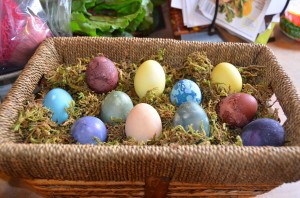
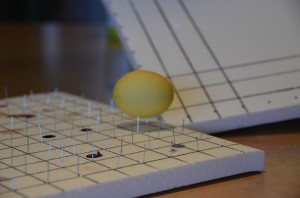
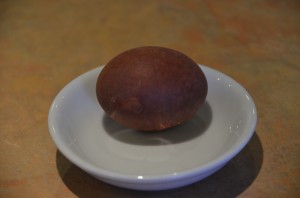
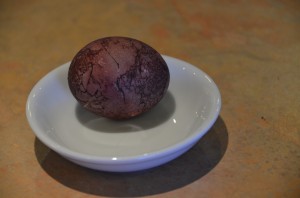
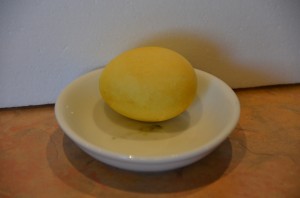
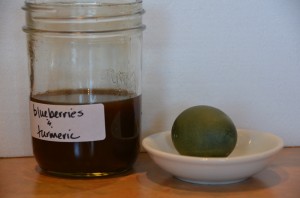
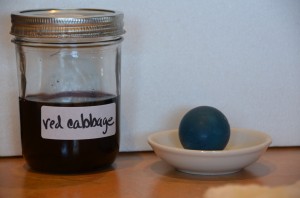
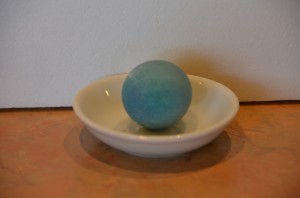
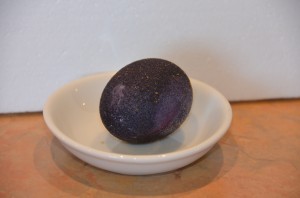








No Comments
There are currently no comments on easter egg dyeing with food. Perhaps you would like to add one of your own?